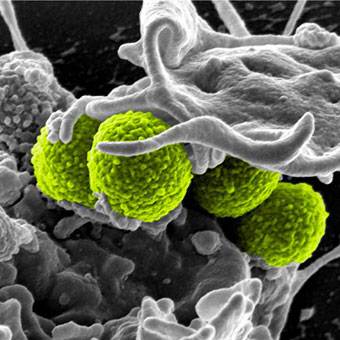
Family members of patients recently discharged from the hospital may have a higher risk of getting an antibiotic-resistant infection, often called a superbug, even if the patient was not diagnosed with the same infection, suggesting hospitals play a role in the community spread of resistant bacteria, according to study in Infection Control & Hospital Epidemiology, the journal of the Society for Healthcare Epidemiology of America.
When recently hospitalized patients were diagnosed with the superbug — Methicillin-resistant Staphylococcus aureus infection (MRSA) — the risk to relatives living with them was even higher. The longer the relative’s hospital stay, even without a MRSA diagnosis, the higher the risk to family members. “Patients can become colonized with MRSA during their hospital stay and transmit MRSA to their household members,” said Aaron Miller, PhD, lead researcher on the study and research assistant professor of internal medicine-infectious diseases at University of Iowa. “This suggests hospitals contribute to the spread of MRSA into the community through discharged patients who are asymptomatic carriers.”
Miller recommends hospitals enhance infection control practices, including testing for MRSA colonization, especially at discharge, even with there are no symptoms of infection. He said MRSA colonization and infections could be tracked among hospital patients and their household contacts to identify and mitigate transmission more effectively.
“This important study illustrates the risk of spread of resistant pathogens related to healthcare and highlights the essential importance of core infection practices,” said SHEA President Thomas Talbot, M.D., chief hospital epidemiologist at Vanderbilt University Medical center. Talbot was not involved with the research. “Hand hygiene, environmental cleaning, and standard interventions to reduce Staphylococcal colonization are crucial to preventing the spread of resistant bacteria in healthcare settings,”
MRSA infections are known as superbugs because they do not respond to common antibiotics, making them difficult to treat. MRSA generally occurs in people who have been in a hospital or another health care setting, such as a nursing home, but MRSA also spreads in communities outside the hospital, usually through skin-to-skin contact. Most people with MRSA have no symptoms, but the bacteria can cause painful swelling if it gets under the skin, and it can be deadly if it spreads to other parts of the body, such as blood or lungs.
Researchers used a large database of insurance claims that included 158 million enrollees with two or more family members on the same plan to learn about how MRSA spread to after someone in a household had been in the hospital.
Reviewing 424,512 MRSA cases among 343,524 insured people, the study found 4,724 cases of MRSA being potentially transmitted to a family member from a relative who had recently been in the hospital and had a diagnosis of MRSA. They also found 8,064 potential transmissions of MRSA after the hospitalization of a family member who did not have a MRSA infection.
“It is important not over-emphasize the hospital stay risk,” Miller said. “While we identified a significant risk factor for transmission in the household and community the absolute risk remains relatively low.” People exposed to a recently hospitalized family member with MRSA were more than 71 times, or 7000%, more likely to get a MRSA infection compared to enrollees who did not have a family member who had been in the hospitalized or exposed to MRSA in the previous 30 days.
Having a family member in the household who was hospitalized but did not have MRSA increased the chances of a relative getting MRSA in the month after discharge by 44%. The more time the family member spent in the hospital, the higher the likelihood someone in their household would get MRSA. If the patient was in the hospital one to three days in the previous month, the chance of a relative getting MRSA increased by 34% compared to people with no recent hospitalizations in their household. If a family member was hospitalized for four to 10 days, the chances of MRSA infection in a relative were 49% higher, and with hospitalizations longer than 10 days the odds of relative in the same household getting an infection rose by 70% to 80%. Other factors associated with MRSA infections among household members included number of other illnesses, prior antibiotic usage, and the presence of young children in the family.
Infection Control and Hospital Epidemiology: “Hospitalizations among family members increase the risk of MRSA infection in a household”. DOI: 10.1017/ice.2024.106
